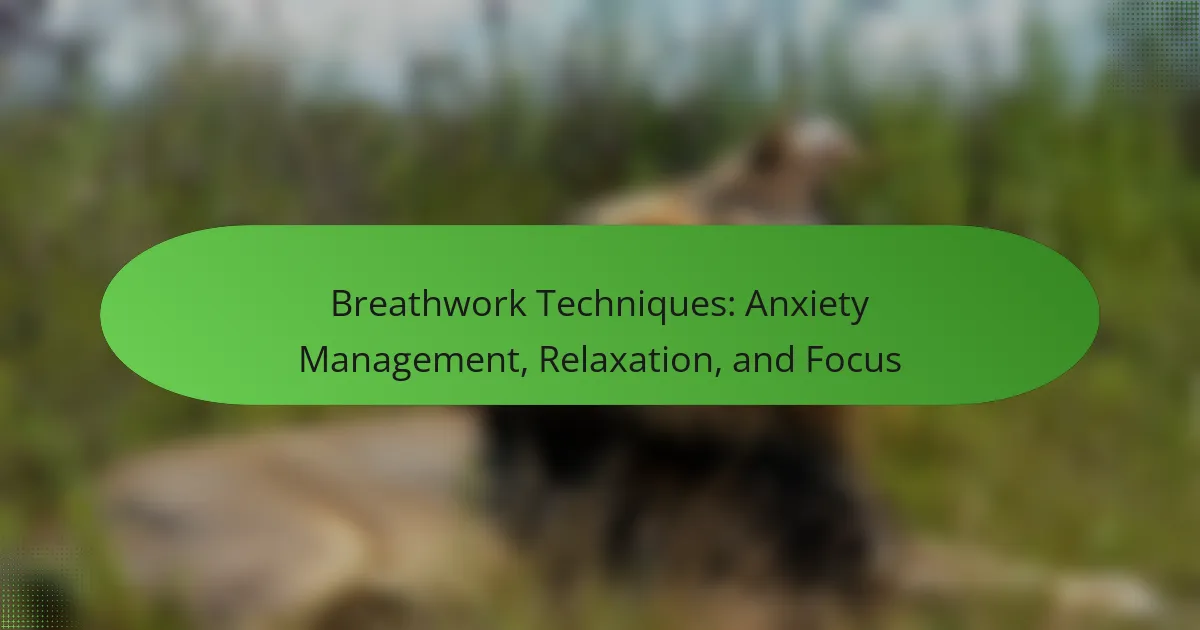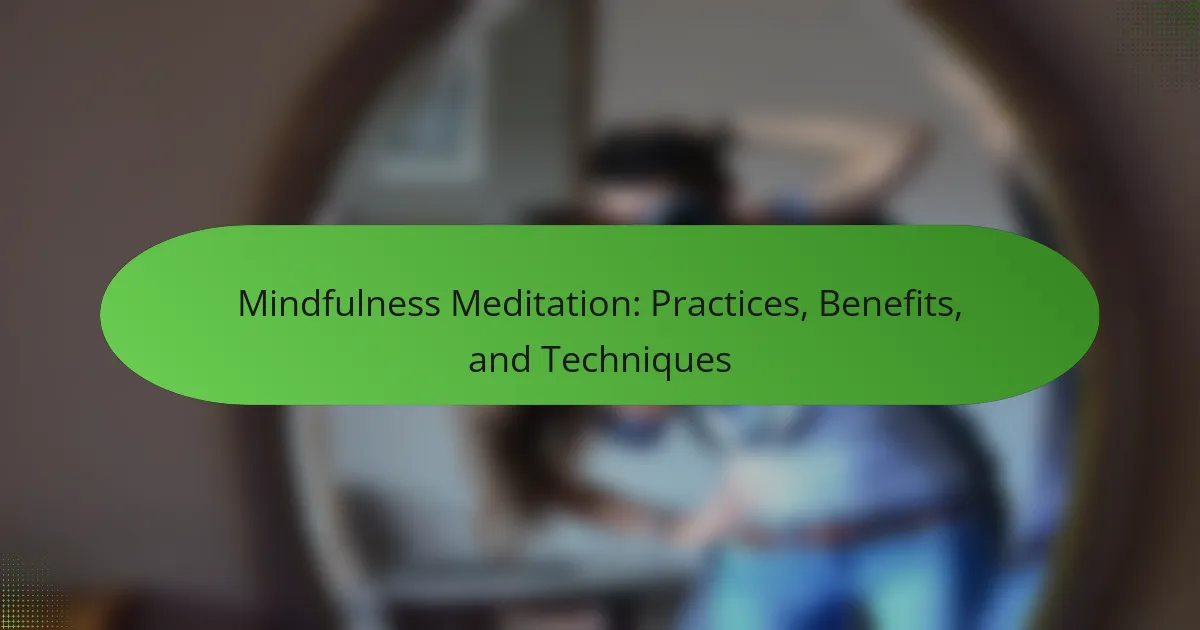Breathwork techniques offer powerful tools for managing anxiety, fostering relaxation, and enhancing focus. By regulating the body’s stress response through specific breathing patterns, these practices promote a sense of calm and mental clarity. Easily accessible and effective, breathwork can be practiced anywhere to support emotional well-being and improve concentration.

How Can Breathwork Techniques Help Manage Anxiety?
Breathwork techniques can significantly aid in managing anxiety by promoting relaxation and enhancing emotional control. These practices help regulate the body’s stress response, enabling individuals to feel calmer and more focused.
Reduces stress hormones
Breathwork can lower levels of stress hormones, such as cortisol, in the body. By engaging in deep, controlled breathing, individuals signal to their nervous system that it is safe to relax, which can lead to a decrease in anxiety symptoms.
Practices like diaphragmatic breathing or box breathing are effective methods to achieve this. Regular practice can help maintain lower stress hormone levels over time, contributing to overall anxiety management.
Enhances emotional regulation
Breathwork techniques enhance emotional regulation by fostering a greater awareness of one’s emotional state. This awareness allows individuals to respond to anxiety-provoking situations with more control and less impulsivity.
For example, techniques such as 4-7-8 breathing can help individuals pause and assess their feelings before reacting, leading to more measured responses to stressors.
Promotes relaxation response
Engaging in breathwork activates the body’s relaxation response, which counteracts the fight-or-flight reaction associated with anxiety. This response can be triggered through practices like slow, rhythmic breathing.
Incorporating breathwork into daily routines, even for just a few minutes, can help cultivate a sense of calm and reduce overall anxiety levels.
Improves mindfulness
Breathwork improves mindfulness by encouraging individuals to focus on their breath and the present moment. This practice helps to quiet racing thoughts and reduce anxiety by anchoring attention away from worries.
Mindful breathing exercises, such as focusing on the sensation of air entering and leaving the body, can be particularly beneficial for those struggling with anxiety.
Supports cognitive clarity
Breathwork supports cognitive clarity by increasing oxygen flow to the brain, which can enhance focus and decision-making. When anxiety is reduced, mental fog often lifts, allowing for clearer thinking.
Practicing breathwork techniques before engaging in tasks requiring concentration can lead to improved performance and reduced anxiety levels, making it a valuable tool for students and professionals alike.

What Are Effective Breathwork Techniques for Relaxation?
Effective breathwork techniques for relaxation involve specific patterns of breathing that help reduce stress and promote a sense of calm. These methods can be easily practiced anywhere and are beneficial for managing anxiety and enhancing focus.
Diaphragmatic breathing
Diaphragmatic breathing, also known as abdominal or belly breathing, focuses on engaging the diaphragm fully. This technique encourages deeper breaths, allowing more oxygen to enter the lungs and promoting relaxation.
To practice diaphragmatic breathing, sit or lie down comfortably. Place one hand on your chest and the other on your abdomen. Inhale deeply through your nose, ensuring your abdomen rises while your chest remains still. Exhale slowly through your mouth. Aim for 5-10 minutes daily to experience its calming effects.
Box breathing
Box breathing is a structured technique that involves inhaling, holding, exhaling, and holding the breath again for equal counts. This method can help stabilize your emotions and improve concentration.
To perform box breathing, choose a count that feels comfortable, such as 4 seconds. Inhale through your nose for 4 seconds, hold your breath for 4 seconds, exhale through your mouth for 4 seconds, and hold again for 4 seconds. Repeat this cycle for several minutes, adjusting the count as needed.
4-7-8 breathing
The 4-7-8 breathing technique is designed to promote relaxation and help with sleep. It involves a specific rhythm of inhaling, holding, and exhaling that can calm the nervous system.
To practice 4-7-8 breathing, inhale quietly through your nose for 4 seconds, hold your breath for 7 seconds, and exhale completely through your mouth for 8 seconds. Start with four cycles and gradually increase as you become more comfortable with the technique.
Alternate nostril breathing
Alternate nostril breathing, or Nadi Shodhana, is a yoga practice that balances the body’s energy and calms the mind. This technique involves breathing through one nostril at a time, which can enhance focus and reduce anxiety.
To perform alternate nostril breathing, sit comfortably and use your right thumb to close your right nostril. Inhale deeply through your left nostril, then close it with your right ring finger. Release your thumb and exhale through your right nostril. Inhale through the right nostril, close it, and exhale through the left. Continue this pattern for several minutes, focusing on your breath and the sensations in your body.

How Do Breathwork Techniques Improve Focus?
Breathwork techniques enhance focus by increasing oxygen intake, promoting relaxation, and sharpening mental clarity. These practices help individuals center their thoughts, reduce anxiety, and create a conducive environment for concentration.
Increases oxygen flow
Breathwork techniques, such as deep diaphragmatic breathing, significantly increase oxygen flow to the brain. This enhanced oxygen supply can lead to improved alertness and mental clarity, which are essential for maintaining focus during tasks.
To practice, try inhaling deeply through your nose for a count of four, holding for a count of four, and exhaling through your mouth for a count of six. Repeat this cycle for a few minutes to experience the benefits of increased oxygen flow.
Enhances concentration
Engaging in breathwork can enhance concentration by calming the nervous system and reducing stress. When the body is relaxed, the mind can focus better on the task at hand without being overwhelmed by external distractions.
Consider setting aside a few minutes each day for focused breathwork. Techniques like box breathing, where you inhale, hold, exhale, and hold again for equal counts, can help train your mind to concentrate more effectively.
Reduces distractions
Breathwork helps reduce distractions by promoting mindfulness and grounding techniques. By focusing on your breath, you can shift your attention away from intrusive thoughts and external stimuli that may disrupt your focus.
To minimize distractions, practice breath awareness by simply observing your breath without trying to change it. This can help create a mental space that is less susceptible to interruptions.
Boosts cognitive performance
Regular breathwork practice can boost cognitive performance by enhancing memory and decision-making skills. Improved oxygen levels and reduced stress contribute to a more efficient brain function, allowing for quicker processing of information.
Incorporate breathwork into your daily routine, especially before engaging in mentally demanding tasks. A few minutes of focused breathing can prepare your mind for optimal performance, making it easier to tackle complex challenges.

What Are the Prerequisites for Practicing Breathwork?
Practicing breathwork effectively requires a few essential prerequisites to ensure safety and maximize benefits. Understanding your personal limits, creating a safe environment, and setting clear intentions are fundamental steps to prepare for a successful breathwork experience.
Understanding personal limits
Recognizing your personal limits is crucial before engaging in breathwork. This involves being aware of any physical or emotional conditions that may affect your practice, such as anxiety disorders, respiratory issues, or recent trauma. Start with shorter sessions, gradually increasing duration as you become more comfortable.
Listening to your body is key. If you feel lightheaded, anxious, or uncomfortable, it’s important to stop and reassess your approach. Consider consulting a healthcare professional if you have concerns about how breathwork may impact your health.
Creating a safe environment
A safe environment enhances the breathwork experience by minimizing distractions and promoting relaxation. Choose a quiet space where you feel comfortable and secure, free from interruptions. Soft lighting and calming scents, like essential oils, can further enhance the atmosphere.
Ensure that the temperature is comfortable and that you have a supportive surface to sit or lie on. Having a blanket or cushion can also help you feel more at ease during your practice.
Setting clear intentions
Setting clear intentions helps focus your breathwork practice and guides your experience. Before starting, take a moment to reflect on what you hope to achieve, whether it’s reducing anxiety, enhancing relaxation, or improving focus. Write down your intentions if that helps clarify your goals.
Keep your intentions simple and specific. For example, you might intend to cultivate a sense of calm or to release tension in your body. Revisit these intentions throughout your practice to maintain focus and enhance your experience.



